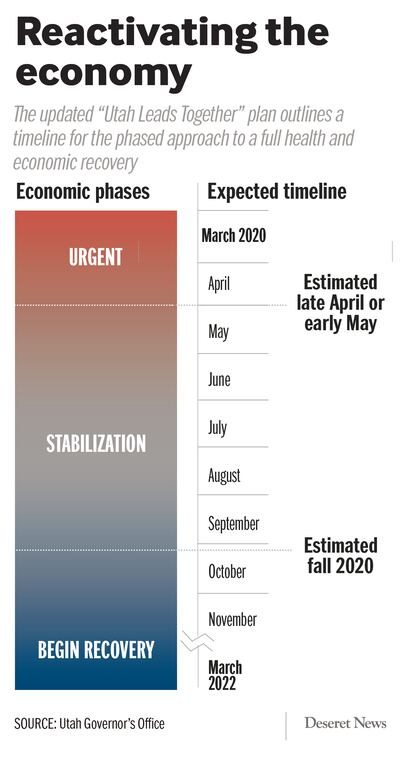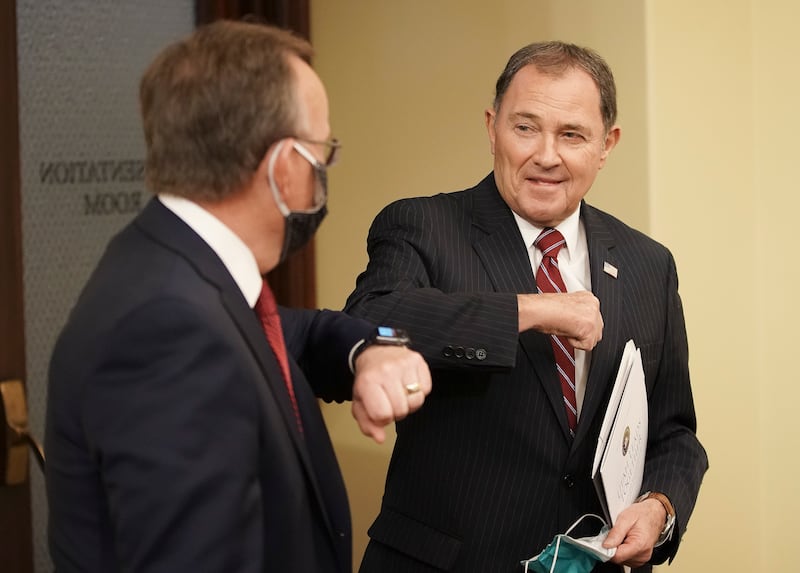SALT LAKE CITY — Gov. Gary Herbert announced Friday that by early May, some businesses in Utah could reopen while continuing practices like social distancing and wearing masks to prevent the spread of COVID-19, as the state moves toward a “phased-in reactivation of our economy.”
The governor went ahead Friday and lifted restrictions on Utahns visiting state parks located outside of the counties where they live, and expressed hope that the five national parks located in the state could reopen soon, at least to Utah residents.
“It’s not time to spike the football,” Herbert said, but offered what he called good news for Utahns who have been under his “stay home, stay safe” directive since March. The restrictions limiting Utahns to essential movement were recently extended through May 1.
But if Utahns continue to follow social distancing and other protective measures, sit-down dining could be allowed at restaurants, gyms could be reopened and elective surgery permitted by early May, the governor said during an online news conference from the Capitol.

“We’re close to that but we’re not quite there yet. A lot will depend on what we do over these next couple of weeks, all of us individually,” Herbert said. “The trend looks positive but now is not the time for us to pull back on our safety protocols.”
Salt Lake County Mayor Jenny Wilson announced some minor changes to the county’s health order Friday, telling residents they can now enter restaurants to pick up food — as long as they continue to adhere to social distancing guidelines.
“We haven’t seen enough success to feel that we can go from zero to 100 and lift restrictions fully. But we are seeing some progress,” said Wilson, adding that both inside and outside seating in the county is still prohibited, and that restaurants will require patrons to maintain social distancing.
“The heart of our order was ‘stay home.’ We’re starting to feel like our data and our information that we’re getting in most areas is strong enough that we can feel comfortable going out again,” said Wilson. “But again, taking our best friend — the mask — with us.”
Herbert touted an updated “Utah Leads Together” plan for a health and economic recovery from the deadly virus, which now promises an end to the urgency in dealing with COVID-19 by late April or early May, shifting to a stabilization phase expected to last until fall before Utah moves into a recovery phase.
“The good news for us here in Utah is we are not having to scramble because we already have a plan in place which we have been implementing for now over a month,” the governor said, calling it complimentary to President Donald Trump’s plans for states to begin reopening. “Our plan is working.”







He said, however, that more needs to be done when it comes to testing Utahns for the new coronavirus to ensure the curve of cases continues to decline and warned that older residents and those with compromised health still need to be “extra cautious” about their vulnerability as the state eases toward an economic recovery.
“This is not like a light switch, that it’s off and now we switch it and it’s on. This is more like a dial,” the governor said, that will reopen the economy incrementally while continuing to protect the health of Utahns. His plan shows a color-coded dial — ranging from red to orange to yellow to finally green labeled “new normal.”
Herbert said he is not worried that the state is moving too quickly.
“We don’t want to go too fast but we also don’t want to go too slow, either,” he said. “This is about finding appropriate balance. It’s not just only about health care. It’s also concern about the livelihood of those that we represent, too. It’s not one versus the other.”
Data is driving decisions, the governor said.
“We’ve not let this become fear-mongering, which some are out there doing. This is also not about politics, but some are out there utilizing this as a political tool. This is about data, good science and good medicine and the advice we’re getting from our medical advisers,” he said.
The state health department says it backs the governor’s plan.
“The Utah Department of Health has been included in the creation of both versions of the ‘Utah Leads Together’ plan. The plan represents a strong collaboration from leaders in both health and economics. We are fortunate in Utah to have leaders who are focused on both economic recovery and ensuring the health of our state’s residents,” department spokeswoman Charla Haley said.
Derek Miller, Salt Lake Chamber president and CEO and chairman of the governor’s Utah Economic Response Task Force, said detailed guidelines for businesses intending to reopen are part of the updated plan. He said preparing to reopen businesses began on “day one” of the state’s coronavirus response.
Miller said he believes businesses “will be diligent in staying safe and protecting their customers while remaining open for business” by keeping workspaces clean and encouraging employees to continue to work remotely whenever possible.
“It is one thing for businesses to be open and it is something else for a customer to feel comfortable enough to walk through that door,” he said. “The measured approach that is contemplated in this plan is not just about how a business can begin to turn the dial and reactivate the economy, it is also about building consumer confidence.”
The updated plan from Herbert will encourage “Utahns to stay engaged in the economy,” Miller said, by providing “a road map for Utahns to see the light at the end of the tunnel, to inspire hope, and to demonstrate a vision for the public safety and economic renewal we all seek.”
House Speaker Brad Wilson, R-Kaysville, said even Utahns who haven’t contracted the virus are being affected in a “different way and a significant way,” losing jobs and businesses. “We have to do more to help these victims of the virus and restart the economic engine of the state,” Wilson said.
The speaker said the governor’s “2.0” plan shows the state is now in a position to begin that process of moving from red to orange on the dial, assuming “a moderate level of risk” that allows Utahns to return to work and get the economy back up and running.
Both the speaker and Senate President Stuart Adams, R-Layton, brought up legislation passed Friday during the special online session of the Legislature that creates a new commission to advise the governor on reopening the economy. Herbert signed the bill later Friday.
The “Public Health and Economic Emergency Commission,” which would be largely made up of gubernatorial and legislative appointees, must make its initial recommendation no later than Wednesday, and the governor would have until the end of the month to either follow it or explain why he isn’t doing so.
Adams said that is “an aggressive timeline,” and that he’s “very hopeful that we can do the things we need to, to have what I call sustainable social distancing.” He said that may mean restaurants keep patrons 6 feet apart and employees wear masks in the workplace.
The Senate president said he is “very encouraged” by how the state is responding so far, citing businesses and religious organizations that have stepped up to help in the crisis.
President Jean B. Bingham, Relief Society general president of The Church of Jesus Christ of Latter-day Saints, spoke at the news conference about “Project Protect,” to sew 5 million masks and produce other protective gear for health care workers.
The effort is led by Intermountain Healthcare, University of Utah Health, Latter-day Saint Charities and several Utah nonprofits.
Also Friday, Gary Edwards, the Salt Lake County Health Department’s executive director, rolled out new guidelines for restaurant employees, saying they are now required to wear a mask at all times, and won’t be able to prepare food if they handled cash or credit cards that day.
The Salt Lake County mayor also addressed a rally scheduled for this weekend where business owners and others hope to push state leaders to reopen Utah’s economy, reminding residents that mass gatherings — which she called “our greatest enemy” — are still a violation of the county’s health order.
“From what I heard they are pushing for social distancing, but a rally is a rally, it’s a mass gathering, and that is prohibited.” Jenny Wilson said. “I think anyone who is considering that should know that.”
Contributing: Ashley Imlay, Kyle Dunphey









